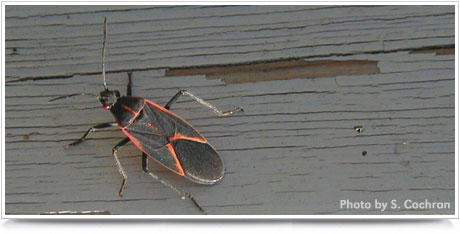Insect Pest Management
This section discusses insect management. Topics include prevention, pesticide use, how to decide if treatment needed.

Insect pest problems are often more severe in rural areas because insects are closely associated with plants, wild and domestic animals, organic wastes and ponds - plentiful resources found in rural settings.
 Ticks thrive where grasses and weeds are tall. Mow lawns and ditches near homesteads regularly, inspect people and pets for ticks. Area-wide insecticide applications are rarely effective.
Ticks thrive where grasses and weeds are tall. Mow lawns and ditches near homesteads regularly, inspect people and pets for ticks. Area-wide insecticide applications are rarely effective.
Pest Prevention - Good sanitation practices include:
- mowing yards regularly
- discarding decaying garden produce
- prompt manure removal in animal pens
- caulking cracks and crevices around the home exterior
- inspecting pets and people for ticks after they have been in tick-infested areas
- controlling rodents and birds around buildings
Prudent Pesticide use Includes:
- reading the label
- wearing protective clothing
- applying pesticides carefully: do not mix, apply or dispose of herbicides, fungicides, insecticides, or rodenticides near streams or wells, where they can leak into groundwater;
- storing pesticides properly: keep in original container; lock away from feed and foodstuffs; moisture-proof storage is important;
- using only when necessary
Before you Decide to Treat:
- Identify the insect and determine if it is a pest. Most insects are harmless and many are beneficial.
- Find out what will happen if you take no action. Many insects disappear within a few days or weeks.
- Learn whether the pest can be controlled using least-toxic control methods. Most pests are vulnerable to some least-toxic controls.
- Find out if insecticides will control the problem and what type of chemical is most appropriate.
Source: Adapted for Lancaster County, Nebraska from A Place in the Country: The Acreage Owner's Guide (EC97-2506C).
For more information on Insects, Spiders & More, Visit HERE
More Acreage Resources & Small Farm Resources